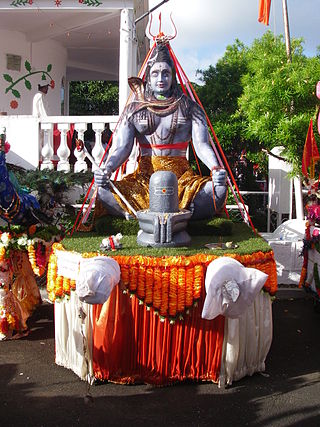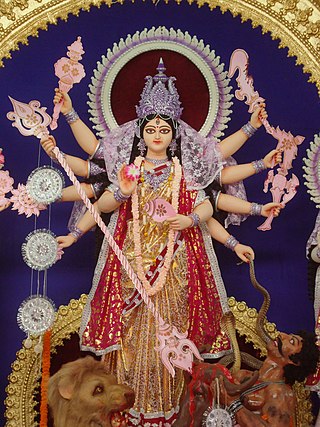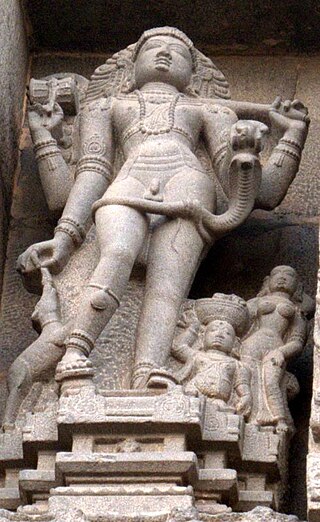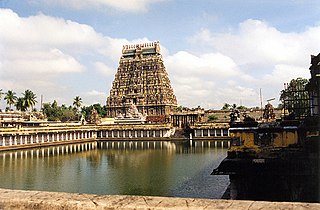
Shiva, also known as Mahadeva or Hara, is one of the principal deities of Hinduism. He is the Supreme Being in Shaivism, one of the major traditions within Hinduism.

Shaivism is one of the major Hindu traditions, which worships Shiva as the Supreme Being. One of the largest Hindu denominations, it incorporates many sub-traditions ranging from devotional dualistic theism such as Shaiva Siddhanta to yoga-orientated monistic non-theism such as Kashmiri Shaivism. It considers both the Vedas and the Agama texts as important sources of theology. According to a 2010 estimate by Johnson and Grim, Shaivism is the second-largest Hindu sect, constituting about 253 million or 26.6% of Hindus.

Ishta-deva or ishta devata, is a term used in Hinduism denoting a worshipper's favourite deity.

Maha Shivaratri is a Hindu festival celebrated annually in honour of the deity Shiva, between February and March. According to the Hindu calendar, the festival is observed on the fourteenth day of the first half of the lunar month of Phalguna. The festival commemorates the wedding of Shiva and Parvati, and the occasion that Shiva performs his divine dance, called the Tandava.

Omkareshwar is a Hindu temple dedicated to Shiva, located in Mandhata, nearby Khandwa city in Khandwa district of the Indian state of Madhya Pradesh. It is one of the 12 revered Jyotirlinga shrines of Shiva. It is on an island called Mandhata, near Khandwa city in the Narmada River at Khandwa district in Madhya Pradesh, India; the shape of the island is said to be like the Devanagari ॐ symbol.

The Smartatradition, also called Smartism, is a movement in Hinduism that developed and expanded with the Puranas genre of literature. It reflects a synthesis of four philosophical strands, namely Uttara Mīmāṃsā, Advaita, Yoga, and theism. The Smarta tradition rejects theistic sectarianism, and is notable for the domestic worship of five shrines with five deities, all treated as equal – Ganesha, Shiva, Shakti, Vishnu and Surya. The Smarta tradition contrasted with the older Shrauta tradition, which was based on elaborate rituals and rites. There has been a considerable overlap in the ideas and practices of the Smarta tradition with other significant historic movements within Hinduism, namely Shaivism, Brahmanism, Vaishnavism, and Shaktism.

The Linga Purana is one of the eighteen Mahapuranas, and a Shaivism text of Hinduism. The text's title Linga refers to the iconographical symbol for Shiva.

A shaligram, or shaligrama shila, is a fossilized stone or ammonite collected from the riverbed or banks of the Kali Gandaki, a tributary of the Gandaki River in Nepal. It is also considered a form of Vishnu within Hinduism.The Kali Gandaki river flows through sacred places such as Muktinath and Damodar Kunda, enhancing the spiritual significance of these shaligrams.
Shanmata meaning "Six Sects" in Sanskrit, is a system of worship, believed in the Smarta tradition to have been founded by the Hindu philosopher Adi Shankara, whose lifetime was during circa 8th century CE. It centers around the worship of six primary deities of Hinduism: Shiva, Vishnu, Shakti, Ganesha, Surya, and Skanda. It is based on the belief in the essential oneness of all deities, the unity of Godhead, and their conceptualization of the myriad deities of India as various manifestations of the one divine power, Para Brahman.

Panchayatana puja also known as Pancha Devi Deva Puja is a system of puja (worship) in the Smarta sampradaya, which is one of four major sampradaya of Hinduism. It consists of the worship of five deities set in a quincunx pattern, the five deities being Ganesha, Adi Shakti, Shiva, Vishnu and Surya. Sometimes an Ishta Devata or Kartikeya is the sixth deity in the mandala.

Kedarnath Temple is a Hindu temple, one of the twelve jyotirlinga of Shiva. The temple is located on the Garhwal Himalayan range near the Mandakini river, in the state of Uttarakhand, India. Due to extreme weather conditions, the temple is open to the general public only between the months of April and November. During the winters, the vigraha (deity) of the temple is carried down to Ukhimath to be worshipped for the next six months. Kedarnath is seen as a homogeneous form of Shiva, the 'Lord of Kedarkhand', the historical name of the region.

The Sree Vaikom Mahadeva Temple is a temple dedicated to the Hindu god Shiva in Vaikom, Kerala, India.

The Biraja Temple, or Birija Kshetra, is a historic Hindu temple located in Jajpur, Odisha, India. The present temple was built during the 13th century. The principal idol is Devi Durga, who is worshipped as Viraja (Girija), and the temple gave Jajpur the nicknames "Viraja Kshetra" and "Biraja Peetha". The Durga idol has two hands (dwibhuja), spearing the chest of Mahishasura with one hand and pulling his tail with the other. One of her feet is on a lion, and the other is on Mahishasura's chest. Mahishasura is depicted as a water buffalo. The idol's crown features Ganesha, a crescent moon and a lingam. The temple covers a large area, and has several shrines to Shiva and other deities. According to the Skanda Purana it cleanses pilgrims, and it is called the Viraja or the Biraja kshetra. Jajpur is believed to have about one crore of Shiva lingams.

Shakti is the fundamental cosmic energy and a central deity within Shaktism, a significant theological tradition of Hinduism. Representing dynamic forces that permeate the universe, Shakti embodies feminine energy and is often depicted as the consort of Shiva. In this tradition, Devi, the Goddess, is regarded as the Supreme Brahman herself, with all other divine forms seen as her manifestations. The worship of Shakti entails a diverse array of goddesses, including Durga, Kali, Parvati, and Tripura Sundari, each representing unique facets of her power.
Hindu denominations, sampradayas, traditions, movements, and sects are traditions and sub-traditions within Hinduism centered on one or more gods or goddesses, such as Vishnu, Shiva, Shakti and so on. The term sampradaya is used for branches with a particular founder-guru with a particular philosophy.

Bhikshatana or Bhikshatana-murti is an aspect of the Hindu god Shiva as the "Supreme mendicant" or the "Supreme Beggar". Bhikshtana is depicted as a nude four-armed man adorned with ornaments who holds a begging bowl in his hand and is followed by demonic attendants and love-sick women.

Iconography of Shiva temples in Tamil Nadu is governed by the Shaiva Agamas (IAST:Āgama) that revere the ultimate reality as the Hindu deity, Shiva. Āgama in the Hindu religious context means a traditional doctrine or system which commands faith. Temple worship according to Āgamic rules can be said to have started during the Pallava dynasty in South India, but they were fully under establishment during the Chola dynasty The temples during the Chola period expanded to Sri Lanka and islands in South East Asia. The temple complex was expanding with niches for various deities on the stipulated sides of the sanctum. Lingam was universalised and prakarams (precincts) with subsequent deities came up. The temple parivara expanded considerably during the Chola period. The niches of following Āgamic rules for building Shiva temples in Tamil Nadu, a South Indian state continues even in the modern era. Some of the prime images like that of lingam, Vinayagar and Parvati are present in all the Shiva temples. Almost all the temples follow the same custom during festivals and worship methods with minor exceptions. Most of the Shiva temples in Tamil Nadu and Sri Lanka are built in Dravidian architecture.

A lingam, sometimes referred to as linga or Shiva linga, is an abstract or aniconic representation of the Hindu god Shiva in Shaivism. It is typically the primary murti or devotional image in Hindu temples dedicated to Shiva, also found in smaller shrines, or as self-manifested natural objects. It is often represented within a disc-shaped platform, the yoni – its feminine counterpart, consisting of a flat element, horizontal compared to the vertical lingam, and designed to allow liquid offerings to drain away for collection. Together, they symbolize the merging of microcosmos and macrocosmos, the divine eternal process of creation and regeneration, and the union of the feminine and the masculine that recreates all of existence.
Sri Dwadasha Jyotirlinga Temple is located in Bangalore, in the state of Karnataka, India. The temple is located in Omkar Ashram, in Omkar Hills Bangalore. Omkar Hills in Srinivasapura is one of the highest points of Bangalore. The Sri Dwadasha Jyotirlinga Devasthana is unique, and one of the most magnificent and gigantic temples in Karnataka.

Lingōdbhava(also called Lingobhava, the "emergence of the Linga") is an iconic representation of Hindu god Shiva, commonly seen in temples in Tamil Nadu.

















